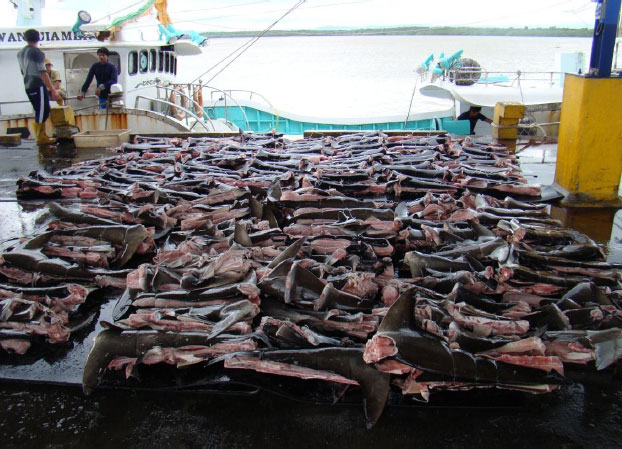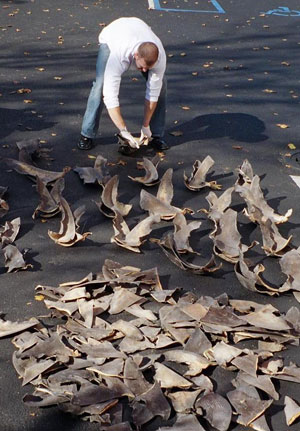It may surprise you that Costa Rican law permits cutting off the fins of sharks and exporting the fins overseas.
The shark fin industry in Costa Rica took off from the 1970s as a result of the growth in demand from the emerging wealthy economies of the Asia-Pacific region for shark fin as a delicacy. By the 1990s, the shark fin industry in Costa Rica had become one of the world’s most important in shark fins, especially as a major cargo-unloading point for international fleets because of tax laws and government corruption.
As of Tuesday, March 2, that trade has been discontinued, at least for the time being.
On Tuesday, Costa Rica’s Environment Ministry issued a decree suspending for six months the issuance of permits to export hammerhead shark fins. The executive president of the Environment Ministry’s National System of Conservation Areas (SINAC), Julio Jurado – said that SINAC will not issue additional export permits for shark fins until criteria are defined that ensure potential exports will not further endanger the marine animals. That criteria will include a report to determine whether the commercial exploitation of hammerhead sharks is possible without further threatening the species’s survival. The government’s official position will be based on that report.
Gutiérrez said SINAC only had authorized shipments of fins that had been landed with the fins still attached to the bodies, which is in line with Costa Rican law enacted in 2005. Sidestepping that law proved to be relatively easy for fishermen, however.
In 2011, a case was brought to the attention of the Costa Rican Coast Guard revealing a new method of removing shark fins to prevent arrest under the Fishing and Aquaculture law, which prohibits shark fishing with the sole aim of removing their fins. The National Coast Guard raised the alert about shark finning following the seizure of shark fins in Costa Rican territorial waters. The method involved capturing the sharks which were then cut into pieces or gutted, leaving just a thin strip of skin to which the fins were attached. The skin was then folded over, leaving the fins “naturally attached” as required under Costa Rican law, so that from a distance the shark looked smaller but whole. The suspects attempted to deceive the authorities with this new technique.

Shark fins attached to the spinal column by strips of skin were seized from Taiwanese boats in Costa Rica in 2011. (Courtesy of Interpol)
In January 2011, it was reported that British chef Gordon Ramsay and his TV crew were held at gunpoint and soaked with petrol when filming a documentary about the illegal trade in Costa Rica. According to Ramsay, shark finning in Costa Rica is “A multi-billion dollar industry, completely unregulated. We traced some of the biggest culprits to Costa Rica. These gangs operate from places like forts, with barbed wire and gun towers.” In response to poor incomes and pressure, local fisherman are forced into harvesting shark fins, despite only getting about one dollar per pound on an average, less than a third of its total retail value. Corrupt politicians are silenced with a fee to ignore government regulations. The practice involves sharks being caught by a horizontal drag line with many baited hooks, known as longline fishing. According to biologist Jorge Ballestero of the Costa Rican Sea Turtle Restoration Project (Pretoma) “Costa Rica has become intricately linked to this trade for two reasons: It has the biggest longliner fleet in the hemisphere, and it allows international vessels dedicated to the exploitation and trade of shark fins to land here.”
The Taiwanese mafia dominate the shark finning industry in Costa Rica, although Indonesian gangs also have a foothold in the market. The Taiwanese and Indonesian mafia operate private docks in the Puntarenas area, notably Inversiones Cruz Dock and Harezan Dock and several others where some 95% of all catches are brought in, transported by truck to San José and flown mostly to Hong Kong. According to the Costa Rican customs adviser Omar Jiminez, at least three boats full of shark fins enter the ports in Puntarenas every week. Kaohsiung in Taiwan is one of the biggest ports in the world for importing shark fins. They are brought in from overseas and are placed out to dry in the sun on residential rooftops near the port.
Shark finning – driven by Asia’s demand for shark fin soup – has decimated shark populations worldwide, bringing several species to the brink of extinction. Another large demand for shark cartilage is for manufacture of “Shark Cartilage Powder” or pills as a cure for cancer.
Since the late 1980s populations of northwest Atlantic coastal and oceanic shark have dropped by an average of 70%, and in 2003 the World Conservation Union (IUCN) estimated that tens of millions of sharks are finned and discarded at sea every year. It is estimated that 80,000,000 – 200,000,000 sharks are killed worldwide each year, mostly for their fins alone. More than 90 percent of the populations of some shark species have been wiped out in the last 15 years.


